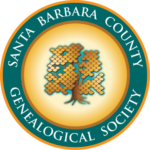Exhibit: Santa Barbara Asian American & Pacific Islander Heritage, 1870s-1970s
Masato “Mas” Okamoto (1922-2000) and Grace Hisako (Nakada) Okamoto (1928-2020)
Father and Grandfather, Electrical Engineer, Fisherman, and Artist
Mother and Grandmother, Domestic Engineer, World Traveler, and Artist
By Melinda Yamane Crawford
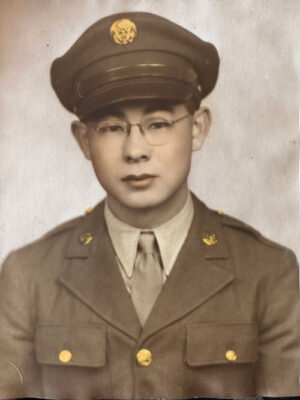
Masato Okamoto in U.S. Army uniform, World War II (Courtesy of John Okamoto)
Masato’s Early Family History
When Masato Okamoto was born on July 5, 1922 in Upland, California, his father, Tsurumatsu Okamoto (1879-1958), was 43 and his mother, Iso Yamamoto (1895-1975), was 26. His parents were born in Kagawa-ken, Japan, and his father worked as a self-employed citrus farmer. Between 1917-1932, Tsurumatsu and Iso had three sons and four daughters, all of whom were born and raised in Upland until the family’s incarceration during World War II.
Life During World War II
The Okamoto family were incarcerated at Poston, Arizona on the Colorado River from 1942-1945. On October 31, 1944, Masato enlisted in the U.S. Army and served in the Military Intelligence Service (MIS). He was stationed in Tokyo, Japan with the 5250th Technical Intelligence Company. He was both an interpreter for civilian scientists collecting technical data from all Mitsubishi Companies and a translator of Japanese documents in preparation for their submission to Washington, D.C.
While in training at the Military Intelligence Language School at Fort Snelling, Minnesota, and as happenstance would have it, one of Masato’s future brothers-in-law, Yoshinao Nakada, would lead them as they marched to class to Sousa marches. Yoshinao, himself, was an instructor at the Military Intelligence Service Language School.
Early Career as an Electrical Engineer
After graduating from UC Berkeley with a bachelor’s degree in electrical engineering on the GI bill, Masato got a job in 1951 in Los Angeles, and he worked for five years in an architect and engineering firm, after which he worked for a mechanical and electrical consulting firm in Pasadena.
Masato Meets Grace Nakada
Masato, his older brother Keith, and Minoru Nakada, were all graduates of UC Berkeley, as was Minoru’s future wife, Rose.
Quoting an interview with son, John Okamoto, on March 22, 2023:
My mom’s older brother, Minoru, was roommates with Dad. Keith [Masato’s brother], Uncle Min and Dad hung out all the time. Dad didn’t know Mom at the time; he knew other family members. Uncle Min was working as a physicist at Livermore, was going from some labs in Livermore to take a job at NASA in Washington, D.C. Uncle Min had his PhD in physics and decided that he and his wife, Rose, were going back to D.C. So, Dad was back in L.A., and Uncle Min said, “Hey, Rose and I need help moving and everything, and can you bring up my little sister, Grace? Maybe you guys can help us get everything packed for our move across the country.” I think Dad said that it was his roommate’s way of setting him up with his little sister.
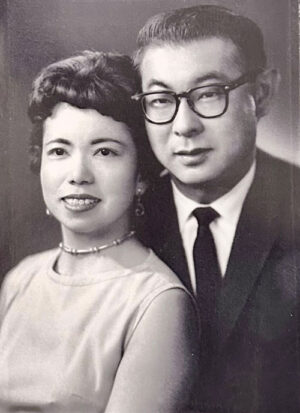
Grace and Masato Okamoto (Courtesy of John Okamoto)
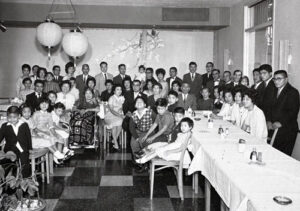
Grace and Masato Okamoto’s Wedding Reception following their Elopement, 1962 (Courtesy of John Okamoto)
We don’t know the whole story but somehow, they started going out and got married; and Dad used to brag about this story:
In the early 1950s and after graduating from UC Berkeley, he bought the cabin in Mammoth. We saw the sale for that was $5K. He loved to fish. He was an Eagle Scout and Scout Master in L.A., and was big in scouting, backpacking, hiking and being outdoors. He bought a cabin where he had done some backpacking during his youth. We still have that cabin. The thing he bragged about was: “We got married in Carson City by the Justice of the Peace, it cost me $5 and we honeymooned at the cabin I already owned and I got to go fishing.” And, he offered the same thing to me when I got engaged.
On August 31, 1962, Masato married Grace Hisako Nakada. She was the daughter of Ginzo Nakada (1884-1963) and Kagi Ikehara (1899-1964) and was born in Los Angeles, CA on Christmas Day 1928.
A Family of Artists

Grace’s ceramics on display (Courtesy of John Okamoto)
In 1965, the Okamoto family moved from Los Angeles, CA to the Santa Barbara area, where Masato took over the Electrical Department for Archer, Spencer Engineering Associates, Inc. He worked there from 1965-1997 and retired in 1997 as the president of the company.
Grace, after jobs in Los Angeles’ Police Department as support staff and as a private travel agent, balanced work in the home with artistic pursuits. In fact, both she and Masato were talented artists. Grace trained as a potter and later as a basket weaver; she also loved to make fish prints using fish that the family caught. Masato blossomed as a visual artist (pastels) after his retirement. Both showed their work in local venues.
Their two sons, Rich and John, were brought up in Goleta, CA, attending local schools. Rich pursued a career in educational administration, and now works as the Director of Disability Programs at Seattle University in Washington, and John is an optometrist, with a practice in Roseville, CA. Rich is a multi-instrumentalist who plays ukulele, bass, harmonica and drums while John’s mom had him do pottery and even sold some of his stuff and got him pottery jobs.
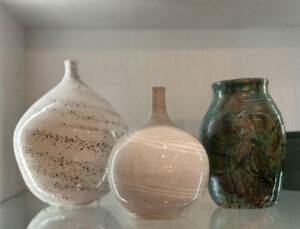
Close-up view of Grace’s ceramics (Courtesy of John Okamoto)
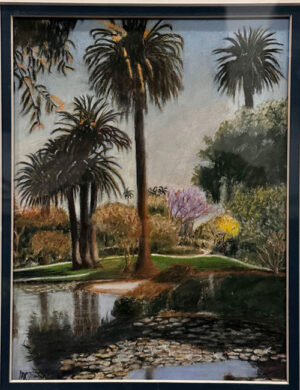
Mas’s painting of Alice Keck Park Memorial Garden, Santa Barbara (Courtesy of John Okamoto)
Acknowledgements
Warm thanks to Rich and John Okamoto for sharing their stories, family histories, and photographs.
References
“Grace Nakada”. Autobiography of Grace Okamoto (Nakada). Copy provided courtesy of son Richard Okamoto.
“Grace Nakada”. California Birth Index, 1905-1995. Accessed on Ancestry.com. State of California, California Birth Index, 1905-1995, Sacramento, CA.
“Grace Nakada”. U.S., Newspapers.com™ Obituary Index, 1800s-current. Accessed on Ancestry.com. The Los Angeles Times; Publication Date: 27 Sep 2020, Los Angeles, CA.
“Masato Okamoto”. Carson City, Nevada, U.S. Marriage Index, 1855-1985. Accessed on Ancestry.com. Carson City Marriage Records. Carson City Recorder’s Office, Carson City, NV.
“Masato Okamoto”. Japanese American Experience Database. Accessed at discovernikkei.org>resources>military (https://discovernikkei.org/en/resources/military/15721/).
“Masato Okamoto”. U.S., World War II Draft Cards Young Men, 1940-1947. Accessed on Ancestry.com. National Archives at St. Louis; St. Louis, MO.
“Masato Okamoto”. Uncle Sat – Interview of 11-9-99. Interview was conducted by Masato’s niece. Copy provided courtesy of son, Ricardo Okamoto.
Okamoto, John and Richard Okamoto. Interview with Melinda Yamane Crawford and Mary Hancock. April 20, 2023.
“Tsurumatsu Okamoto”. U.S., Final Accountability Rosters of Evacuees at Relocation Centers, 1942-1946. Accessed on Ancestry.com. Records of the War Relocation Authority, Record Group 210; The National Archives in Washington, D.C.
“Tsurumatsu Okamoto”. U.S., Newspapers.com Obituary Index™, 1800s-current. Accessed on Ancestry.com. The Pomona Progress Bulletin; Publication Date: 8 Sep 1958; Publication Place: Pomona, CA.
“Tsurumatsu Okamoto”. U.S., World War I Draft Registration Cards, 1917-1918. Accessed on Ancestry.com. Registration State: California; Registration County: San Bernardino County, CA.
